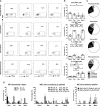Type 2 and Type 17 Invariant Natural Killer T Cells Contribute to Local Eosinophilic and Neutrophilic Inflammation and Their Function Is Regulated by Mucosal Microenvironment in Nasal Polyps
- PMID: 35720287
- PMCID: PMC9204195
- DOI: 10.3389/fimmu.2022.803097
Type 2 and Type 17 Invariant Natural Killer T Cells Contribute to Local Eosinophilic and Neutrophilic Inflammation and Their Function Is Regulated by Mucosal Microenvironment in Nasal Polyps
Abstract
Chronic rhinosinusitis with nasal polyps (CRSwNP) is characterized by heterogeneous inflammatory endotypes of unknown etiology. Invariant natural killer T (iNKT) cells are multifunctional innate T cells that exhibit Th1-, Th2-, and Th17-like characteristics. We investigated functional relationships between iNKT cells and inflammatory subtypes of CRSwNP. Eighty patients with CRSwNP and thirty-two control subjects were recruited in this study. Flow cytometry was used to analyze the frequencies and functions of iNKT cells and their subsets in peripheral blood mononuclear cells (PBMCs) and tissues. Polyp tissue homogenates were used to study the multifunctionality of iNKT cells. iNKT cells were significantly increased in polyps (0.41%) than in control mucosa (0.12%). iNKT cells were determined in the paucigranunlocytic (n=20), eosinophilic (n=22), neutrophilic (n=23), and mixed granulocytic (n=13) phenotypes of CRSwNP. The percentages of iNKT cells and HLA-DR+PD-1+ subsets were lower in eosinophilic or mixed granulocytic polyps than those of other phenotypes. iNKT cells and subsets were enriched in polyp tissues than in matched PBMCs. The evaluation of surface markers, transcription factors, and signature cytokines indicated that the frequencies of iNKT2 and iNKT17 subsets were significantly increased in eosinophilic and neutrophilic polyps, respectively, than in the paucigranulocytic group. Moreover, the production of type 2 (partially dependent on IL-7) and type 17 (partially dependent on IL-23) iNKT cells could be stimulated by eosinophilic and neutrophilic homogenates, respectively. Our study revealed that type 2 and type 17 iNKT cells were involved in eosinophilic and neutrophilic inflammation, respectively, in CRSwNP, while different inflammatory microenvironments could modulate the functions of iNKT cells, suggesting a role of iNKT cells in feedback mechanisms and local inflammation.
Keywords: chronic rhinosinusitis with nasal polyps (CRSwNP); eosinophilia; functional subsets; invariant natural killer T cells; neutrophilia.
Copyright © 2022 Ye, Bao, Chen, Meng, Li, Sun, Li, Lei, Wen, He, Jiao, Fang, Gao and Li.
Conflict of interest statement
The authors declare that the research was conducted in the absence of any commercial or financial relationships that could be construed as a potential conflict of interest.
Figures






Similar articles
-
Type 17 mucosal-associated invariant T cells contribute to neutrophilic inflammation in patients with nasal polyps.J Allergy Clin Immunol. 2023 Nov;152(5):1153-1166.e12. doi: 10.1016/j.jaci.2023.06.021. Epub 2023 Jul 10. J Allergy Clin Immunol. 2023. PMID: 37437744
-
Evaluation of the frequency of invariant natural killer T (iNKT) cells in nasal polyps.Clin Immunol. 2019 Aug;205:125-129. doi: 10.1016/j.clim.2019.05.013. Epub 2019 May 29. Clin Immunol. 2019. PMID: 31152891
-
Transcription factors gene expression in chronic rhinosinusitis with and without nasal polyps.Radiol Oncol. 2019 Jul 17;53(3):323-330. doi: 10.2478/raon-2019-0029. Radiol Oncol. 2019. PMID: 31326962 Free PMC article.
-
The current findings in eosinophilic chronic rhinosinusitis.Auris Nasus Larynx. 2024 Feb;51(1):51-60. doi: 10.1016/j.anl.2023.08.002. Epub 2023 Aug 11. Auris Nasus Larynx. 2024. PMID: 37574421 Review.
-
[Classification of chronic rhinosinusitis with nasal polyps based on eosinophilic inflammation].Zhonghua Er Bi Yan Hou Tou Jing Wai Ke Za Zhi. 2019 Mar 7;54(3):222-226. doi: 10.3760/cma.j.issn.1673-0860.2019.03.013. Zhonghua Er Bi Yan Hou Tou Jing Wai Ke Za Zhi. 2019. PMID: 30909346 Review. Chinese.
Cited by
-
Genetic correlation between chronic sinusitis and autoimmune diseases.Front Allergy. 2024 Sep 24;5:1387774. doi: 10.3389/falgy.2024.1387774. eCollection 2024. Front Allergy. 2024. PMID: 39381510 Free PMC article.
References
Publication types
MeSH terms
LinkOut - more resources
Full Text Sources
Medical
Research Materials

